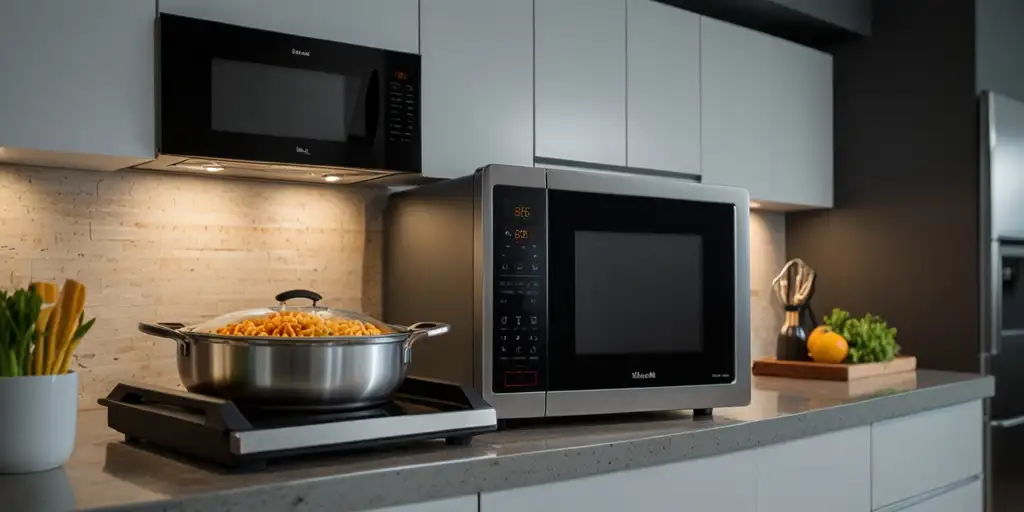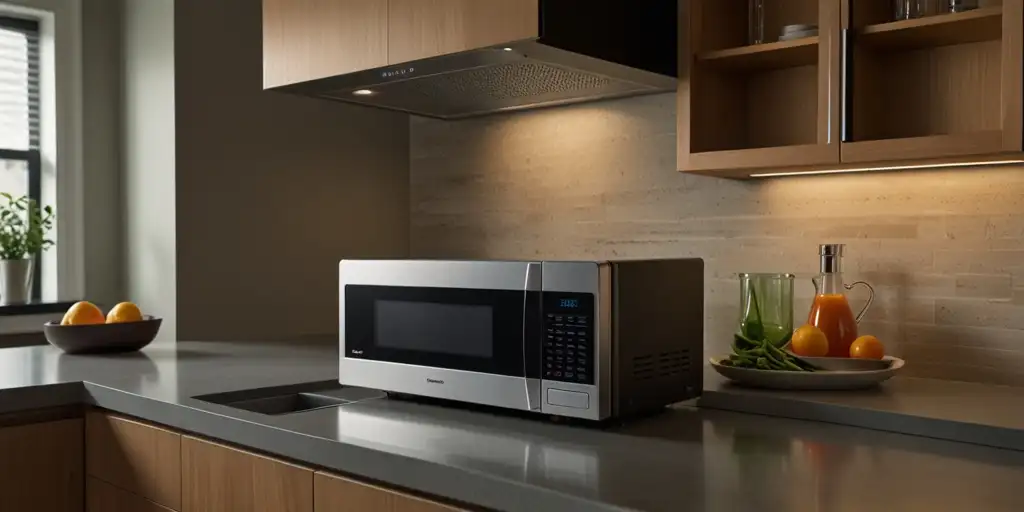Think there’s no significant difference? Discover which kitchen appliance is designed to fit your cooking style best in Microwave vs Microwave Oven! Do you think that one differs from another, where you use one and place another in your kitchen as well?
You may also hear of both, termed a microwave and a microwave oven, respectively. Many of us use “microwave” and “microwave oven” interchangeably, but does this mean they’re truly the same? Or is there more than meets the eye?
We will try to find out what distinguishes a microwave from a microwave oven and how each one might be suitable for varying needs in cooking. A query of this nature such as which mode is better for warming or cooking heavy meals quickly and which one is healthier can easily be settled with an understanding of their different uses in order to make the right decision. Thus, let us explore deeper the details and eliminate any suspicion regarding microwaves, microwave ovens, and the functions of each!
Understanding the Basics: Microwave vs. Microwave Oven
You might be thinking, “Is a microwave oven the same as a microwave?” While they sound alike, there are subtle distinctions that set these two apart. Let’s start with the basics so you can better understand which appliance might be the right fit for your needs.
What is a Microwave?
Microwave vs Microwave Oven: A microwave is a small, efficient kitchen appliance designed to heat food quickly. It uses microwave radiation to agitate water molecules within the food and cook it from the inside out. With its compact size and fast heating capabilities, microwaves have become essential in many homes for reheating leftovers, defrosting meats, and even cooking simple meals.
What is a Microwave Oven?
Hence, is it similar to the fact that when we say ‘microwave oven’, the word oven adds anything significant to > b! umetRC ‘microwaved’? A microwave oven makes use of microwave technology but at times incorporates a few other cooking features such as grill and bake or even convection cooking which tends to be more versatile in terms of cooking. A microwave convection oven can crisp and brown foods in a way that a standard microwave typically can’t. This extra functionality makes it a popular choice for those looking to go beyond just reheating.
Key Similarities Between Microwave and Microwave Oven
While they each have unique features, there are shared characteristics that often cause confusion:
- Speed: Both appliances are designed to cook food quickly, making them ideal for busy kitchens.
- Compact Size: Generally, both microwaves and microwave ovens have a small footprint, perfect for countertop placement.
- Ease of Use: With simple controls and quick cooking times, both are accessible to people of all skill levels in the kitchen.
When to Choose One Over the Other
If you’re trying to decide which appliance will meet your needs best, consider these questions:
- Do you need quick reheating or defrosting? A basic microwave might be all you need.
- Looking to bake or grill? A microwave oven, especially one with convection capabilities, offers more versatility.
Understanding these differences can make it easier to choose the appliance that suits your lifestyle.
Technical Differences Between a Microwave and Microwave Oven
Now that we understand the basics, let’s dig deeper into the technical distinctions between a microwave and a microwave oven. These differences in power, design, and functionality can impact your cooking experience and help you decide which is better for your needs.
Power and Energy Usage
For sure, the primary difference of a standard microwave is energy usage. While the common microwave oven makes use of more watts of power. That would give the oven the power for a great number of appliances such as high power to thaw or freeze, as well as simply warming leftovers within seconds of placing it into the box. In contrast, microwave ovens, especially those with convection features, tend to use higher wattage to support baking, grilling, and even roasting functions. Thus, when weighing the “microwave vs microwave oven,” one sees that a microwave can become more efficient on the terms of energy use.
Heating Mechanism and Technology
These appliances heat food differently. Conventional microwaves work using microwave radiation, which energizes the water molecules inside the food, creating internal heat. A microwave convection oven combines microwave radiation with convection technology—meaning it uses a fan to circulate hot air, allowing for more even cooking, browning, and crisping. This feature makes your microwave oven an all-purpose appliance, which delivers cooking results closer to what you get from a traditional oven.
Design and Structure Variations
The design difference between the two objects of interest in this case can be very inconsequential yet render a difference concerning how they utilize themselves. A fundamental microwave sometimes possesses a simpler design with a rotative platform to provide uniform heating through it. On the other hand, the microwave grill oven models may more frequently include the following parts as well as:
- Convection fans for baking and roasting
- Grill racks to achieve crispy exteriors
- Special trays for browning and even cooking
More of these structural augmentations can enhance the outers of a microwave oven making it more sophisticated and kitchen utensil in its entirety.
Durability and Lifespan
Wondering which appliance is more durable? Generally, microwave ovens are more durable, since they are built to withstand a lot of heat from grilling, baking, and various forms of cooking. A simple microwave is good for when heating food in a hurry, but it will tend to fade sooner if used for tough tasks demanding more power and more regulating of heat.
Therefore, whether you want to find “difference between microwave and microwave oven” or you just want to make your choice, here are the technical insights to guide you to the appropriate appliance for your needs.
Functional Differences in Cooking Capabilities
When it comes to cooking capabilities, the choice between a microwave and a microwave oven can significantly impact your meal preparation. Each appliance excels in different areas, making it crucial to understand their functional differences. Let’s break down how these appliances perform in the kitchen.
Food Types and Cooking Techniques
What kinds of meals do you enjoy preparing? If you’re primarily reheating leftovers or defrosting meats, a basic microwave is likely your best friend. It excels at tasks like:
- Reheating pizza and pasta in minutes
- Defrosting frozen chicken or vegetables quickly
On the other hand, if you enjoy cooking a variety of dishes, a microwave oven offers more versatility. It can handle:
- Baking cakes and cookies
- Roasting meats for a delicious, tender outcome
- Grilling veggies and seafood to perfection
By knowing what you often cook, you can choose the appliance that suits your culinary style.
Cooking Speed and Efficiency
In the busiest of lives, time is precious. How long would it take you to get a meal ready? Ordinary microwaves do truly shine in terms of speed, heating up the meal in a matter of seconds compared to that old traditional oven. Even if they take a few extra moments for some jobs, this is balanced by cooking ability.
For example, baking a potato will take a bit longer in a microwave oven, but it will come out fluffier and better homogeneously cooked because of the mixture of microwave and convection heating. Compare cooking times and decide which one suits your everyday needs.
Versatility: From Simple Heating to Full Meal Preparation
Are you looking for an all-in-one kitchen companion? If versatility is your goal, a microwave oven could be your ideal choice. Many models offer multiple cooking modes, including:
- Convection mode for baking
- Grill mode for crispy finishes
- Defrost and reheat settings tailored for various food types
This multifunctionality means you can tackle everything from a quick snack to a full dinner party without needing multiple appliances cluttering your countertop.
Common Cooking Modes and Options
Let’s delve into the popular cooking modes available in both appliances:
- Standard Microwave Modes:
- Reheat: Perfect for leftovers, allowing you to warm food evenly.
- Defrost: Safely thaws meats and frozen foods without cooking them.
- Microwave Oven Modes:
- Bake: Ideal for cakes, cookies, and other baked goods, providing a golden finish.
- Grill: Gives meats and vegetables a lovely char and crispy texture.
- Combination Cooking: A blend of microwave and convection for optimal results.
In line with this, you will appreciate what each appliance has to offer and therefore guarantee that you buy the correct one that suits your taste and way of living in terms of cooking.
Pros and Cons: Microwave vs. Microwave Oven
Even as we continue our comparison of microwave and microwave ovens, as we already did earlier, we must balance the advantages and disadvantages of each model. This should give one a make-or-break choice for them with any change in their habits and preference for cooking. Let us break down what each kitchen appliance has to offer for you.
Advantages of Microwaves
Microwaves are beloved for their simplicity and efficiency. Here are some notable benefits:
- Speed: Microwaves heat food incredibly fast, making them perfect for busy individuals or families. Need a quick meal? A microwave can have your leftovers hot in minutes!
- Energy Efficiency: Since they cook food quickly, microwaves generally use less energy than traditional ovens, saving you money on your electricity bill.
- Compact Size: They take up minimal counter space, making them an excellent choice for small kitchens or apartments.
- User-Friendly: With straightforward controls, even novice cooks can confidently operate a microwave, making meal prep hassle-free.
Disadvantages of Microwaves
While microwaves have plenty of perks, they also come with some drawbacks:
- Limited Cooking Techniques: If you enjoy baking or roasting, a standard microwave may not satisfy your culinary ambitions. It’s primarily designed for reheating and defrosting.
- Texture Issues: Microwaved food can sometimes lack the crispy texture achieved by traditional cooking methods. For instance, pizza may come out chewy instead of crispy.
- Uneven Heating: Microwaves can occasionally leave hot spots and cold spots in food, leading to uneven cooking. This is why stirring and rotating are often recommended!
Advantages of Microwave Ovens
Now, let’s explore the benefits of microwave ovens, which offer more versatility:
- Versatility: You can make Different Dishes in the Microwave Ovens with Baking, Grilling, and even Convection features.
- Better Texture: The usage of convection feature will moreover, result to even better cooking effects where food will be cooked crispy brown on all sides rather efficiently.
- Advanced Features: Many models come equipped with smart technology, where programmable settings and mobile control can be added, which further enhance your experience.
Disadvantages of Microwave Ovens
Despite their numerous advantages, microwave ovens also have some downsides:
- Higher Cost: Generally, it is more pricey than ordinary microwaves because they have advanced technologies and are capable of almost everything.
- Size: They may take up more counter space, which could be a concern for those with limited kitchen real estate.
- Learning Curve: With various settings and modes, it may take some time to learn how to maximize a microwave oven’s potential.
Making the Right Choice
So, which one should you choose? The decision ultimately hinges on your cooking style and needs. Here are some guiding questions to help you decide:
- Do you primarily reheat leftovers and need something quick? A standard microwave could be your best option.
- Do you enjoy cooking a variety of dishes and want an appliance that can handle it all? A microwave oven might be worth the investment.
In consideration of the advantages and disadvantages, it is certain that one will select the appliance that enhances their cooking experience the most. Be it a microwave or a microwave oven, knowing what each of them is capable of doing makes cooking such scrumptious meals easy!
Key Considerations When Choosing Between Microwave and Microwave Oven
When it comes to selecting the right appliance for your kitchen, there are several factors to consider. The decision between a microwave and a microwave oven isn’t just about personal preference; it also depends on your cooking habits, kitchen space, and budget. Let’s explore some key considerations to help you make an informed choice.
1. Cooking Needs and Preferences
What types of meals do you typically prepare? If your cooking style leans towards quick reheating and simple tasks, a microwave may suffice. However, if you enjoy experimenting with different recipes, a microwave oven offers greater versatility. Consider the following:
- Frequent Reheating: If you often reheat leftovers, a microwave is a time-saving solution.
- Diverse Cooking: For those who love to bake, grill, and roast, a microwave oven provides the tools necessary for a wide range of culinary adventures.
2. Kitchen Space and Size
How much room do you have in your kitchen? The size of your appliance can significantly impact your kitchen layout. Here’s what to keep in mind:
- Compact Microwaves: Ideal for small kitchens or apartments, these appliances fit easily on countertops without consuming too much space.
- Larger Microwave Ovens: While they offer more functionality, they require more counter space. Ensure you measure your kitchen area to find an appliance that fits comfortably.
3. Budget Considerations
What are you willing to invest in a cooking appliance? The cost can vary significantly between a basic microwave and a feature-rich microwave oven. Here are some points to ponder:
- Microwaves: Generally more affordable, they make for a great entry-level option.
- Microwave Ovens: While they come at a higher price point, their multifunctionality may justify the cost, especially if you cook often.
4. Cooking Time and Efficiency
How much time do you spend cooking each day? If you’re always on the go, efficiency might be a top priority. Consider these factors:
- Speed of Cooking: Microwaves are known for their quick heating capabilities, perfect for busy lifestyles.
- Quality of Cooking: Microwave ovens may take a bit longer, but they often produce superior results due to even cooking and browning features.
5. Health and Nutrition
Are you conscious about your cooking methods? Both appliances can help you prepare healthy meals, but there are subtle differences to consider:
- Nutrient Retention: Microwaving can preserve nutrients better than some traditional cooking methods, making it a healthy choice for reheating vegetables.
- Cooking Methods: Microwave ovens often come with grilling and convection options that allow for healthier cooking, reducing the need for added fats or oils.
Conclusion
In conclusion, the debate between a microwave and a microwave oven ultimately hinges on your individual cooking style and lifestyle needs. Have you considered how often you cook, what kinds of meals you prefer, and how much space you have in your kitchen? These factors are crucial when making your choice.
Both have pros that can really alter the face of your kitchen life. A microwave is just for a quick reheat or some simple jobs; a microwave oven will, however, introduce you to the possibilities of baking, grilling, and even roasting. What’s it then, speed and convenience, or versatility and functionality?
As you weigh your options, remember to think about your budget as well. While a basic microwave may be easier on your wallet, investing in a microwave oven could lead to greater culinary creativity and satisfaction in the long run. Plus, with today’s advancements in technology, many microwave ovens come equipped with features that can make cooking healthier and more enjoyable.
Whichever you prefer – a microwave or a microwave oven, the device is bound to complement your cooking abilities, while also saving you some valuable time in the kitchen. So, what is stopping you? Go ahead and check the options that cater to your requirements the best and your next culinary challenge is just around the corner. It all starts with the correct appliance beside you. Enjoy the cooking!


